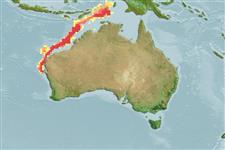Elasmobranchii (tubarões e raias) (sharks and rays) >
Rajiformes (Skates and rays) >
Anacanthobatidae (Smooth skates)
Etymology: bulbicauda: Name from Latin ‘bulbus’ for swelling and ‘cauda’ for tail or appendage, with reference to the flattened expansion of the tail near its tip.
More on authors: Last & Séret.
Environment: milieu / climate zone / intervalo de profundidade / distribution range
Ecologia
marinhas demersal; intervalo de profundidade 150 - 1125 m (Ref. 75174). Tropical; 5°S - 27°S, 111°E - 134°E (Ref. 75174)
Indo-West Pacific: Australia (Shark Bay) and eastern Indonesia (Refs. 75174, 114953).
Tamanho / Peso / Idade
Maturidade: Lm ? range ? - 43 cm
Max length : 43.3 cm TL macho/indeterminado; (Ref. 75174); 56.0 cm TL (female)
Descrição breve
Chaves de identificação | Morfologia | Morfometria
This species is distinguished by the following combination of characters: moderate-sized disc, its width at anterior orbit 5.2-7.8 times mouth width; moderately elongate to short tail, its postcloacal length 79-170% of disc length; relatively large eyes with orbit diameter 4.7-8.8 in horizontal snout and 6.7-10.6 in head lengths, respectively; distal portion of tail expanded laterally in specimens exceeding about 28 cm TL (130 mm DW), width of tail near tip 1.3-2.2 times tail width at its midlength; pectoral-fin radials 66-71; moderate-sized pelvic fins, anterior lobe 12.1-18.1% TL; anterior pelvic-fin lobe rather broad-based, width 1.7-3.2 in distance between pelvic-fin origins; caudal fin rudimentary; tooth rows 20-28, in each jaw of adults; with teeth of adult males with greatly elongated conical cusps; 25-31 abdominal vertebral centra; 148-171 total centra; dorsal surface pale pinkish brown, ventral surface uniformly pale (Ref. 75174).
Body shape (shape guide): other.
Found on outer continental shelf and upper slope. Presumably feeds on small fishes and invertebrates. Males reaches maturity at ca. 43 cm TL; smallest neonatal juvenile 13 cm TL (Ref. 114953)
Life cycle and mating behavior
Maturidade | Reprodução | Desova | Ovos | Fecundidade | Larvas
Last, P.R. and B. Séret, 2008. Three new legskates of the genus Sinobatis (Rajoidei: Anacanthobatidae) from the Indo-West Pacific. Zootaxa 1671:33-58. (Ref. 75174)
Categoria na Lista Vermelha da IUCN (Ref. 130435: Version 2025-1)
Ameaça para o homem
Harmless
Utilização humana
Ferramentas
Relatórios especiais
Descarregue XML
Fontes da internet
Estimates based on models
Preferred temperature (Ref.
123201): 7.8 - 14.6, mean 11.1 °C (based on 40 cells).
Phylogenetic diversity index (Ref.
82804): PD
50 = 0.5020 [Uniqueness, from 0.5 = low to 2.0 = high].
Bayesian length-weight: a=0.01000 (0.00244 - 0.04107), b=3.04 (2.81 - 3.27), in cm total length, based on all LWR estimates for this body shape (Ref.
93245).
Nível Trófico (Ref.
69278): 3.8 ±0.6 se; based on size and trophs of closest relatives
Fishing Vulnerability (Ref.
59153): Moderate vulnerability (42 of 100).
🛈
